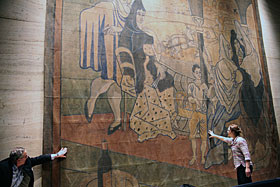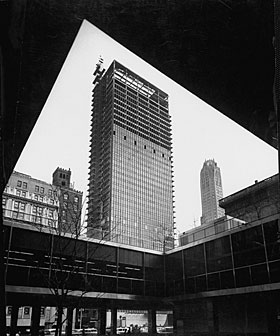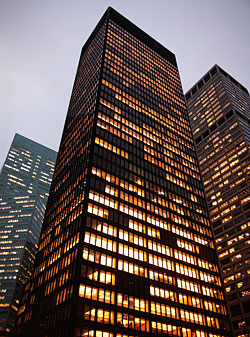The juxtaposition of the old and new in New York’s Seagram Building

Roula Khalaf, Editor of the FT, selects her favourite stories in this weekly newsletter.
A 1919 wall hanging created by Pablo Picasso is at the centre of the latest battle over the historic versus the modern at the Seagram Building in Manhattan.
The dusky mauve and ochre Le Tricorne stage curtain was created for a Russian ballet production and has hung in the Park Avenue office tower’s Four Seasons restaurant for more than half a century. But the building’s current owner, RFR Holding, wants it out.
Aby Rosen, the New York property titan and art collector who co-owns the office tower, has referred to the piece as a rug and a carpet in conversations with the New York Landmarks Conservancy. The preservation group had requested an order – which was granted – temporarily preventing RFR from moving the work, saying shifting the aged piece would destroy it.
Although the property group has said the curtain had to go because of a damaged wall, the NYLC and others believe Rosen – whose tastes run to artists such as Damien Hirst and Jeff Koons – wants to use the space to showcase highlights of his vast trove of postwar gems.
“The curtain was specifically bought for the space. It is a gift to the city and there it should remain forever,” says Peg Breen, NYLC president.

The juxtaposition of the old and new has featured in the narrative of the Seagram Building throughout its life, from its design and ownership to its tenant make-up and artworks.
The Four Seasons restaurant at the base of the building – a go-to lunchtime spot for tycoons and celebrities (regulars include Martha Stewart, Ralph Lauren and Henry Kissinger) – has maintained the same landmarked – or listed – interiors since it opened in the late 1950s. Meanwhile, the revamped office space on the upper floors could rival that of a start-up technology company.
No one understands this convergence better than Phyllis Lambert, daughter of Canadian business magnate Samuel Bronfman, who was the owner of the Seagram Company’s liquor empire. The company had outgrown its rented space in the Chrysler Building amid a booming postwar spirits business and wanted to build a space of its own. But Lambert was horrified at her father’s original plans for a showy metal and glass edifice.
In a letter pleading to her father in 1954, the then 27-year-old Lambert, wrote bluntly: “No, No, No, No, No.” She believed the project would look vulgar and took issue with his characterisation of the building as “Renaissance modernised”. She urged him to construct a tower that did not reference any previous era. “If you are going to make something, you build the most wonderful and best thing you can at the time,” Lambert, now 87, tells the Financial Times.
The vivacious young lady – who went on to establish the Canadian Centre for Architecture – was commissioned to help oversee the design and construction of the new tower. In her 2013 book, Building Seagram, she writes about her role as the young director of planning. After weeks of consultations with architects across the country she settled on the 68-year-old German émigré visionary Ludwig Mies van der Rohe. “Everyone was talking about him,” she says of the younger architects she had spoken to. “It became clear that I had to choose Mies himself.”
The tower was granted landmark status in 1989 after turning 30 years old, in recognition of its enduring design and architectural prowess.

A virtually unlimited budget enabled van der Rohe, alongside American architect Philip Johnson, then his acolyte, to use sumptuous materials. The 38-storey tower faces Park Avenue across a broad plaza of pink Vermont granite, bordered on either side by reflecting pools and ledges of verde antique marble. The tower itself is a steel-framed structure wrapped in a curtain wall of pink-grey glass to complement the bronze spandrels, mullions and I-beams that modulate the exterior surface. Walls and lift banks are lined with travertine panels.
The building took only 18 months to design, another 18 months to construct and at a cost of $36m, it was at the time the most expensive skyscraper ever built.
Seagram took up the first six floors of office space while the Eagle Pencil Company, watchmaker United States Time Corporation, typewriter maker Olivetti, the Public Relations Society of America and television producer Goodson-Todman Productions were among other tenants.
The time over which the building was constructed proved to be a golden period for Seagram, which occupied a dominant position in the US drinks sector. Although the building remains an icon of corporate power, its completion in 1958 signalled the peak of the company’s fortunes.
Seagram’s market share began to drop in the following decade and, in the years after, the company pushed new lines of business, including forays into chemicals and entertainment. Seagram was sold to French media company Vivendi in 2000 and, two years later, the drinks business on which it was founded was disposed of.
In 1979, the skyscraper was sold for $85m to pension fund Teachers Insurance and Annuity Association – College Retirement Equities Fund. In the years leading up to the sale, a recession had enveloped the US and the banks that marketed New York’s debt were convinced the city was on the brink of bankruptcy.
“It was a difficult period to own and acquire new real estate, given the high interest rates and capital constraints,” says Nicholas Stolatis, senior director at TIAA-CREF’s global real estate arm, but “we welcomed the chance to acquire such an iconic property”.
Even though TIAA-CREF owned the building, the Bronfman family remained caretakers and ensured proper maintenance was carried out, including the oiling of the bronze exterior of the building. “This added enormous complexity to everyday upkeep – a challenge we met during our entire period of ownership,” says Stolatis.
Joel Ehrenkranz, whose law firm has been in the building for more than 40 years, says its location, quality and stature explain its rents of up to $200 a square foot. “Other buildings advertise their views of Central Park, but at Seagram you have a rather fabulous view of the city buildings because the plaza sets it back.” Although Seagram, and later Vivendi, continued to occupy the space in some fashion until the mid-2000s, the sale meant TIAA-CREF – and later RFR – was no longer allowed to use “Seagram Building” in its marketing. Even so, 375 Park Avenue was the jewel in the crown of TIAA-CREF’s $40bn property and mortgage portfolio.
One factor prompting the sale of the tower to RFR in 2000 for $375m were the millions of dollars needed to refurbish the property in the coming years, said people familiar with the matter. TIAA-CREF, however, says: “We don’t fall in love with our real estate assets. We considered ourselves stewards of an endearing property, and following an exceptionally long holding period we sold when it made sense.”
Rosen and business partner Michael Fuchs – also the owners of Lever House, a modernist building further up Park Avenue – secured the deal with two investors during a frenzied Manhattan property market. Those who had bought buildings cheaply during the recession of the early to mid-1990s were reaping the benefits of price and rent rises as the economy recovered.

Three-quarters of the roster of prestigious tenants – ExxonMobil and DaimlerChrysler among them – were paying rents below market rates and had leases set to expire within five years. Development rights of the building also spurred an intense bidding war.
“The building is almost my business card. If you own Seagram, suddenly it equates to a certain type of owner who cares about owning a New York landmark,” says Rosen. “You are the custodian of the building and are maintaining it for a future generation. I wanted one on both sides of the street.” Under RFR’s ownership the building has undergone refurbishment, including modernisation of its lifts, electrics, heating and cooling systems, and the replacement of landmarked luminescent ceilings.
But the road to this point has not been easy: RFR was hampered by the most recent financial crisis, which put pressure on the New York office property sector; Rosen became embroiled in a dispute with Seagram investors Harry Lis and Peter Brant that resulted in them being bought out; and the company had to undertake a $1bn refinancing of the property after finding no takers for a stake in it when other large sales in the city had also come to nothing. Even so, the building’s co-owner believes he is holding on to “a piece of history” that he seeks to showcase through public art installations – the building’s rotating sculpture programme has included Jeff Koons’ “Balloon Dog” and Dan Colen’s “Cracks in the Clouds”.
“Aby has tried to bring in tenants with a similar appreciation for art and architecture,” says Gregg Hymowitz, co-founder of EnTrust Capital. The investment group moved into the building in 2010, joining corporations such as banking group Wells Fargo, energy giant ConocoPhillips, hedge fund Third Point and telecommunications company Verizon.
But the building’s oldest and most enduring fixtures remain under pressure; alongside the Picasso curtain, the owners of the Four Seasons are tussling over a steep rent rise. Julian Niccolini co-owns the Four Seasons’ lease alongside business partner Alex von Bidder and the Bronfman family.
Having presided over the city’s lunchtime gold standard for 37 years, he remains positive. “The Four Seasons is an integral part of the building,” he says. “Our lease is with RFR and our future lease will be with them. We have been there since the beginning.”
Comments